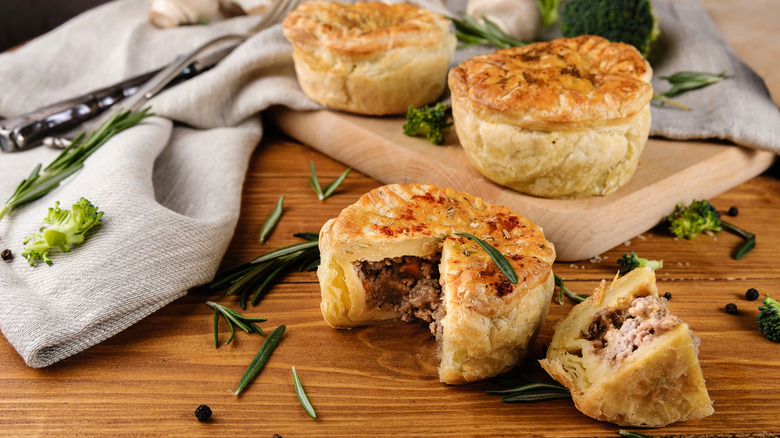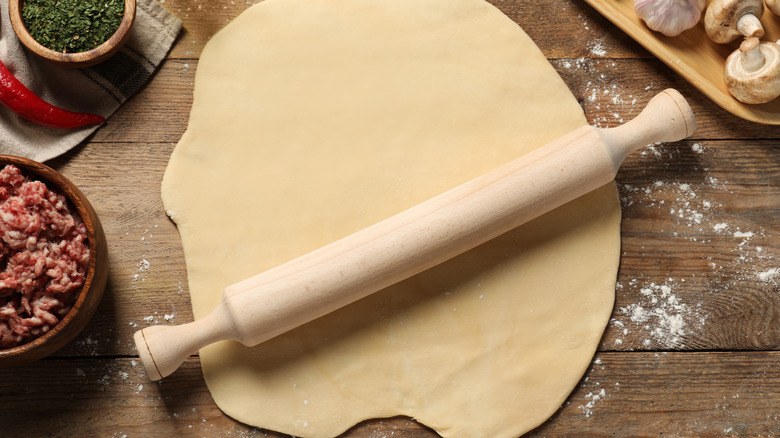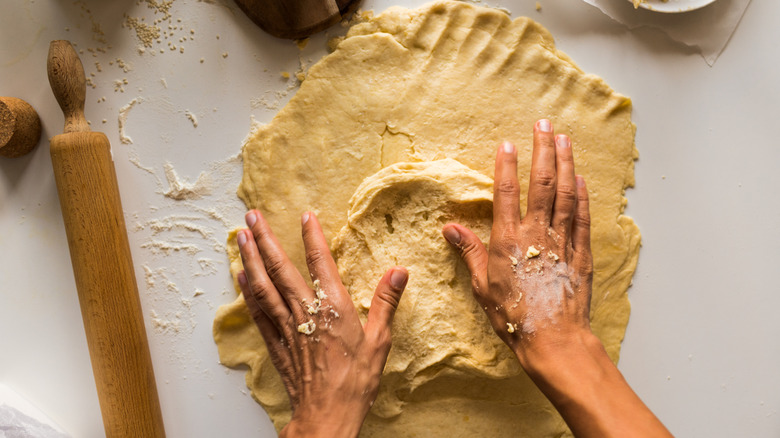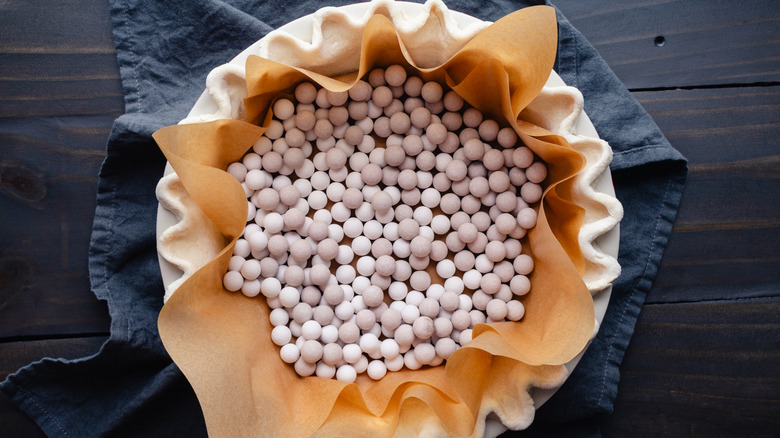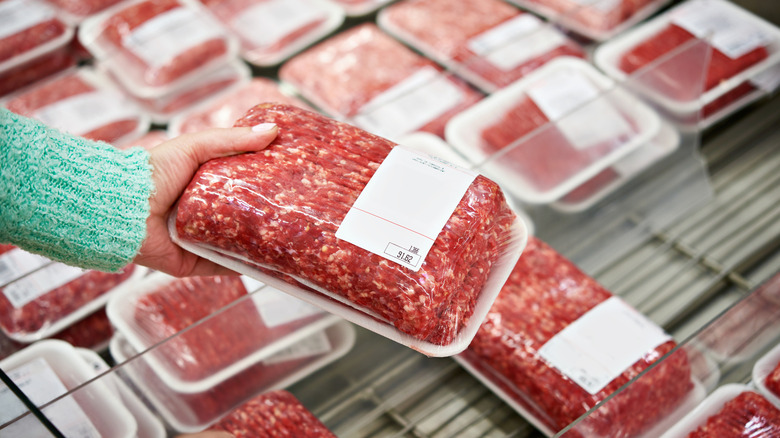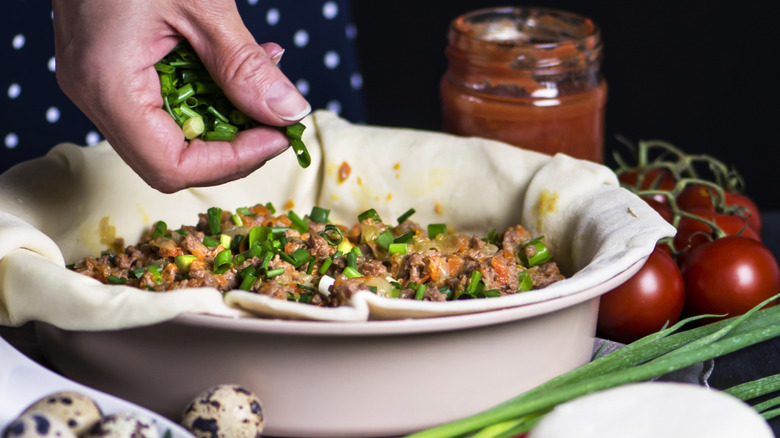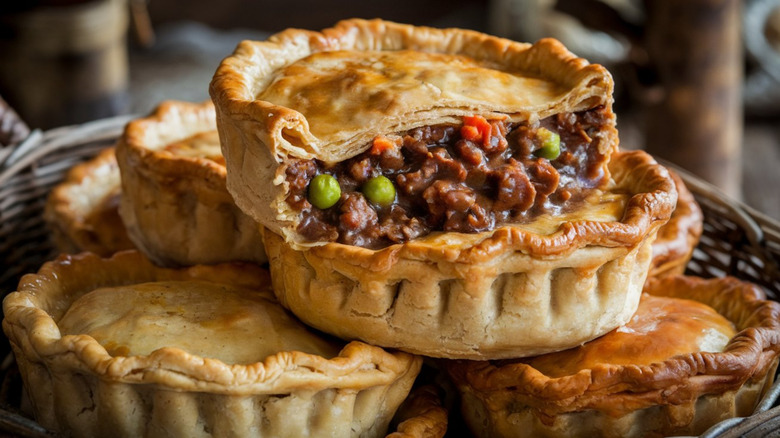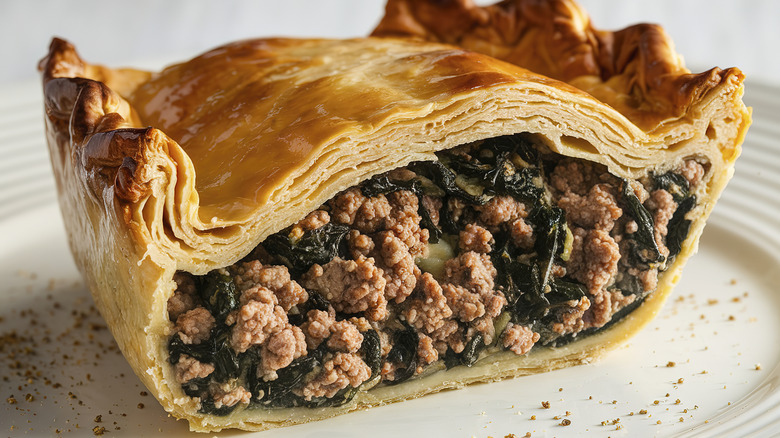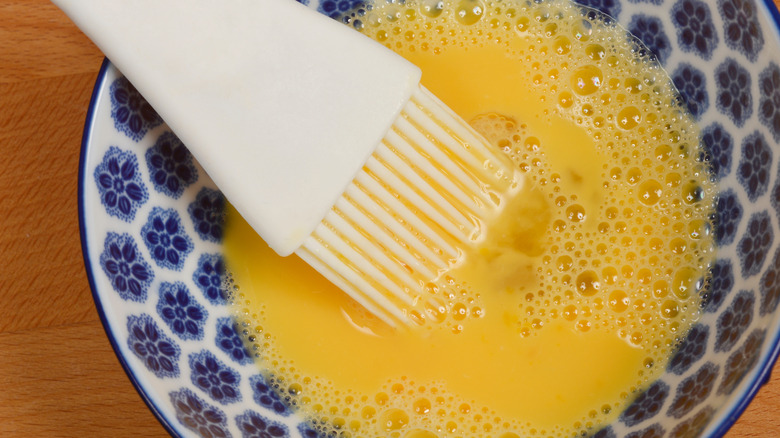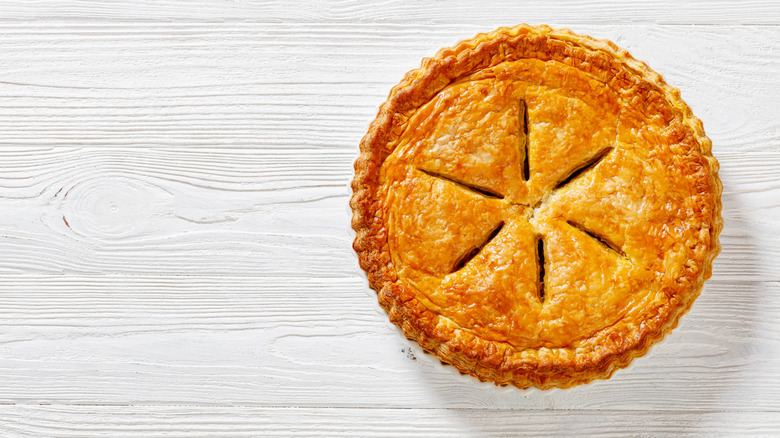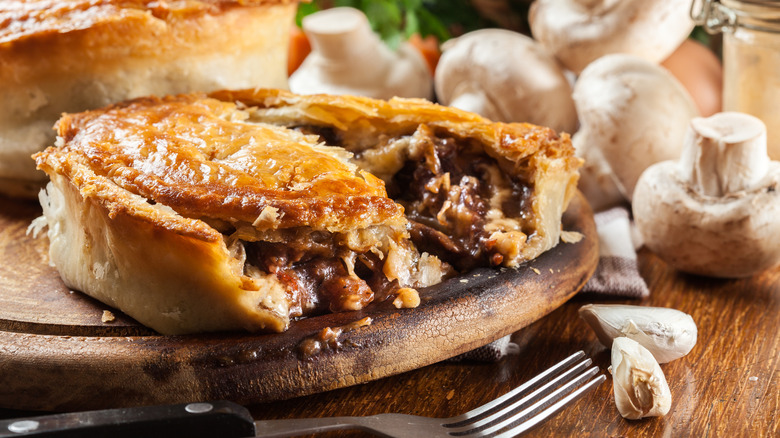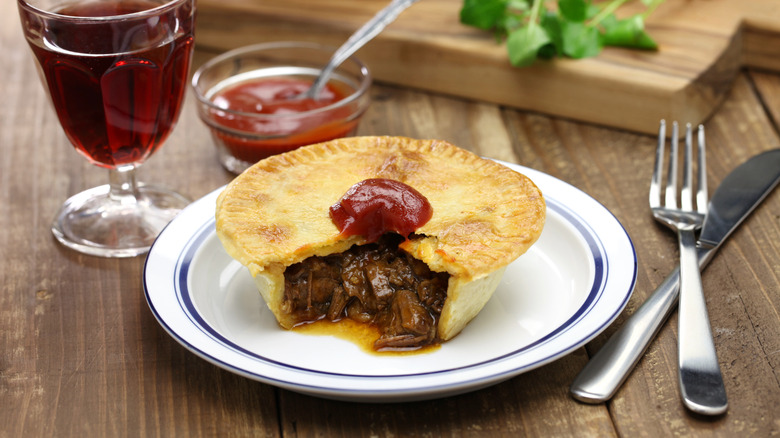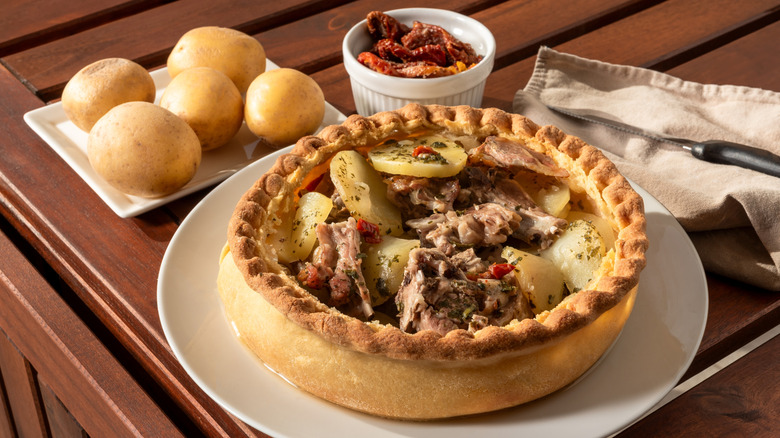13 Mistakes Everyone Makes With Meat Pies
We may receive a commission on purchases made from links.
There's something so satisfying about slicing into a perfect meat pie that you've prepared yourself. Ideally, it should have golden, buttery pastry that breaks open to reveal a rich meaty filling that's tender, juicy, and bursting with flavor. But getting it right is not always easy. There are several steps you need to take to ensure your meat pie has the best possible texture, flavor, structural integrity, juiciness, and crust quality. For many people, nailing down a great meat pie can be challenging. The good news is it doesn't have to be that way.
To better understand where so many people go wrong with meat pies, we spoke to several chefs who have a wealth of experience making all sorts of pies, from classic steak-and-ale pies to Aussie-style meat pies, beef pot pies, and more. They gave us some great insights into common issues people have with the pastry, filling, and flavor profiles. If you're tired of churning out pies that have soggy bases, lackluster seasoning, or fillings that are too dry or watery, these are some mistakes that could be standing between you and meat pie greatness.
Using the wrong type of pastry
To say that Australian-born Jess Pryles has a passion for meat would be an understatement. She's spent over a decade studying everything from meat science to live-fire cooking. She's also written a cookbook called Hardcore Carnivore and created a meat seasoning line of the same name. When it comes to meat pies, she told us the right pastry is key. She said, "While shortcrust is common for the base (you can use a pie crust for a similar result), the top/lid has to be puff pastry. It's flaky and light, and a hallmark of a classic pie."
The reason many chefs believe that two types of pastry are best for steak pies and other meat-filled bakes is because each pastry plays a different role. The shortcrust provides a solid base that can stand up to the meat and saucy gravy. Meanwhile, the puff pastry is light, buttery, and flaky. With each bite, you get a nice textural contrast between the crumbly crust, tender meat, and soft top. It's a classic technique that's often used in Australian and British meat pies.
Overworking the dough
Nicole Hunn is a recipe developer and founder of Gluten Free on a Shoestring, where she showcases how to make a wide range of gluten-free dishes, including pie crust. She's acutely aware of the pitfalls that people encounter with getting pastry just right. She told us, "Crust is a whole beast of its own. People struggle with it because they're either overworking it or panicking about the texture. You want to see visible butter chunks in your dough before it hits the fridge. That's where the flake comes from."
With some doughs, the goal is to make them smooth and elastic, but that's not the case with meat pie pastry. If you knead the dough so much that your butter is fully incorporated throughout, you're going to end up with a crust that's greasy and tough. The goal is to have small chunks of cold butter so that you create fat pockets in the dough. When the crust heats up in the oven, water evaporates from the butter, and that causes flaky layers to form. For evenly mixed pie pastry, Hunn recommends using a food processor to avoid overworking the dough with warm hands.
Neglecting to chill the dough
After your dough has come together just enough so that there are still chunks of butter throughout, Nicole Hunn recommends taking it straight to the fridge. She said, "Chilling your dough — and I mean really chilling it — is crucial. A soft or overly warm dough will melt before it sets in the oven, and that's when you get leaks, slumping sides, or dry fillings." In fact, many of the experts we spoke to agreed that warm butter is the biggest mistake keeping you from a flaky pie crust.
Chilling your dough not only prevents the butter from melting, but it also relaxes the glutens in the dough. This can help make your pie crust more tender and prevent the crust from shrinking while baking. Many chefs recommend wrapping your dough in plastic wrap and chilling it for at least 30 minutes or even overnight. Take it out of the fridge about 10 minutes before rolling it to let it warm up just enough for it to be flexible, but not so much that those butter pockets start to melt.
Not blind baking the crust
A soggy, gummy pie crust is the bane of many bakers' existence. Fortunately, executive chef Dagan Lynn of Beef. It's What's For Dinner has the perfect solution. He told us, "Try par-baking the crust, which means cooking the crust on its own with no filling first until it's golden, and then adding the meat and cooking again. This allows the crust to get nice and crunchy without being impacted by the moisture from the beef and filling."
Par-baking (also known as blind baking) is pretty straightforward, but there are a few steps you need to take to ensure your crust doesn't shrink or puff up too much. The easiest way to blind bake a pie crust is to roll out your chilled dough and place it in your pie plate with a piece of parchment paper over top. Then you add dried beans or pie weights to help maintain the shape of the crust. Bake until the crust is just starting to turn golden, then take it out, remove the parchment paper and weights, and bake it again until the bottom is also golden.
Using the wrong meat in the filling
You can nail the perfect crust, but if the filling isn't right, the whole pie falls flat. For Grace Vallo, founder of Tastefully Grace, the best type of meat to use in meat pie filling is ground beef because it blends well with a variety of ingredients. She told us, "You can say it keeps all the flavors, well, 'grounded.'" Dagan Lynn shared that sentiment, saying, "Lean ground beef or beef chuck are my two favorite cuts because they are flavorful without being too rich, which is important to balance the richness of the pie crust."
Of course, you don't have to stick to just ground beef. Jess Pryles told us, "I love using stewing cuts like chuck roast for a chunkier filling." If you also prefer your meat with a bit more bite, consider choosing tougher cuts of beef that have a decent amount of fat and connective tissue like short ribs, bottom round, or as Pryles mentioned, chuck roast. When cooked low and slow, these cuts break down into soft chunks or shreds and can impart a luscious texture and flavor to your sauce.
Failing to balance the flavors
Nearly every expert we spoke to touched on the fact that a stellar meat pie is more than just the quality of its individual parts. It's also about how it all comes together. As Nicole Hunn said, "What I wish more home cooks understood is that a good meat pie is all about balance. A rich, savory filling with a crust that complements, not competes." A well-balanced meat pie should include a variety of flavors. For example, Grace Vallo recommended rounding out the pie with both savory and sweet flavors. Aromatics like fresh herbs can also help tie it together.
Dagan Lynn noted that while flavors are important, texture is also key. He said, "I recommend a combination of lean ground beef and shredded veggies and starch for added flavor and moisture like carrots, potatoes, and onion. This will give you a satisfying meat pie that doesn't skimp on flavor and isn't overwhelmed by the crust." Thoughtful layering of flavors and textures adds dimension to the filling and ensures the pie feels cohesive instead of just one-note.
Mismanaging moisture levels
Getting the moisture level of the filling right is one of the trickiest parts of making a meat pie. As Jess Pryles said, "If you make it too thick, it will be dry and gluey, but if it's too thin it will just run right out as soon as you bite in, tsumani style." Fortunately, there are a few ways you can fix the filling before it goes in your pie. Dry filling is the easiest to fix because you can simply add more sauce or liquid like stock or water to the meat mixture. Pryles recommends aiming for a consistency similar to chili.
Overly wet filling is more of a problem because, as Nicole Hunn pointed out, it can steam your crust from the inside out and create a soggy bottom. "One trick I use is to let the filling cool completely, even refrigerate it before adding it to the dough," she said. "That way, it doesn't start melting the fat in the crust before baking." Some of the other experts recommended adding cornstarch to help thicken up the gravy. You can also simmer your meat mixture longer to reduce it to a thicker consistency.
Overfilling the pie
It can be tempting to pack in as much filling as your crust will hold, but overfilling a meat pie is a fast track to a sloppy bake. Too much filling puts pressure on the crust, and that can cause it to bulge or split as it bakes. Even if it holds together in the oven, slicing into an overstuffed pie usually results in those tasty ingredients spilling out everywhere. Not only does that ruin the presentation and make for a pretty messy meal, but it also means you're losing valuable flavor and texture with every slice.
Grace Vallo told us, "It's a best practice to measure your filling first to keep all your tasty ingredients where they belong — inside!" Instead of just pouring the filling into the pie shell straight from the pot or bowl, consider using a ladle or spoon so that you can manage just how much goes in. Leaving a bit of space at the top of your pie allows the filling to settle and bubble slightly during baking without busting through the crust. Ideally, you should be able to put the lid on and seal it easily with no filling escaping.
Forgetting to add an egg wash
If you want to give your meat pie a gorgeous golden color and a glossy shine, an egg wash is the way to go. It consists of a beaten egg with optional liquid like water, milk, or cream. You simply brush the mixture over your pastry before you pop it in the oven and the egg wash will work its magic to enhance the appearance of your pie. However, that's not all it can do. As Nicole Hunn told us, "Egg wash isn't just for shine, it helps seal the crust and adds a subtle barrier to moisture."
An egg wash can help seal the top and bottom crusts of your pie together, which is especially useful for preventing leaks at the seams. It also adds a protective layer to help keep the crust from absorbing too much moisture from the filling. Just be sure to apply it evenly with a pastry brush. Too much can pool in the creases or cause uneven browning. A light hand goes a long way toward getting that crisp, golden finish without overdoing it.
Leaving out vents in the pie lid
So you've blind baked your pie crust, added your meat filling without overstuffing, and given your pastry an egg wash. Now it's time to put your pie in the oven, right? Not so fast. According to Dagan Lynn, there's one more step you need to take. He said, "Make sure you cut little vents in the top pie crust. This will release steam from the beef filling and can help prevent the crust from getting soggy." Skipping this step is one of the easiest ways to run into common pie crust mistakes.
As your pie cooks in the oven, water evaporates from the filling. If the steam has nowhere to escape, it will go straight into the crust and potentially waterlog it. That built up steam can also cause the crust to burst. The easiest way to vent your pie is to use a sharp knife to create small cuts in the lid. If you want to get fancy, you can cut shapes like stars or circles. Try to get a few vents evenly spaced around the top of the crust so that steam from different parts of the pie can get out.
Cutting into the pie as soon as it comes out of the oven
Finally, your meat pie is out of the oven and cooked to what looks like perfection. Your first instinct might be to cut into it immediately so that you can savor your masterpiece. However, that could undo all your hard work. It's best to let the filling cool slightly and thicken. If you slice too soon, it can spill out into a soupy mess. Letting your pie rest also helps the crust to firm up, which can make it easier to slice it cleanly without crumbling or tearing.
A good rule of thumb is to let your meat pie rest at least 10 to 15 minutes before cutting into it. If it's a particularly large or deep pie, you may want to bump that up to 20 minutes. During that time, the starches and fats in the filling will settle and reabsorb moisture, giving you neater slices and a better texture. Resting can also improve the flavor. Just like stews and roasts, meat pies can benefit from a short cool-down so the flavors meld more fully. You can keep your pie loosely vented with aluminum foil if you're worried about losing too much heat.
Getting the seasoning wrong
Many home cooks fall into the trap of defaulting to salt, pepper, and maybe a bit of garlic to season their pies, but that's often not enough to make a meat pie stand out. Nicole Hunn noted that warming spices like smoked paprika, cumin, or even cinnamon can add depth, especially when paired with lean meats or gluten-free crusts. Grace Vallo swears by anchovies to add a touch of salty goodness, and Jess Pryles adds Vegemite, which she called, "the secret Aussie umami-bomb."
Getting the seasoning right continues all the way to the plate. Most chefs would agree that you don't want to douse your meat pie with too much additional sauce because that might overpower the flavors of the pie and make the crust soggy. A simple squirt of ketchup or splash of gravy is often enough to add extra flavor. Pryles offered a helpful tip for adding condiments. She said, "The pro move is to lift the lid and put the ketchup straight onto the filling, thereby retaining the flaky integrity of the top pastry."
Being afraid to get creative
With all this talk about multiple mistakes you can make with meat pies, it might seem like playing it safe is the best move, but that's not always true. Several of the chefs we spoke to are big proponents of getting creative with flavors. For example, one of Dagan Lynn's favorite recipes is a beef and spinach pie that adds feta to the mix and features phyllo dough. He said, "I also like a short rib pot pie which swaps your usual ground beef or chuck for beef short ribs combined with herbs, red wine, onion and garlic, all topped with a shortbread dough."
Nicole Hunn is also a big fan of playing around with different meats and veggies. She said, "One of my favorite non-traditional combos is lamb with harissa, sweet potato, and a hint of mint, tucked into a savory crust. Or ground chicken with mushrooms and a splash of soy-free tamari for a gluten-free-friendly umami bomb." You could also try plant-based meats or replace the meat with seafood like in this version of a pot pie with tuna. At the end of the day, it's your pie, so don't be afraid to make it your own.
